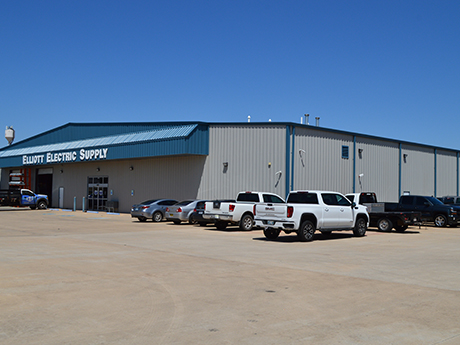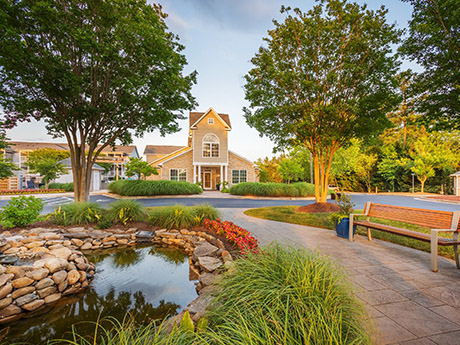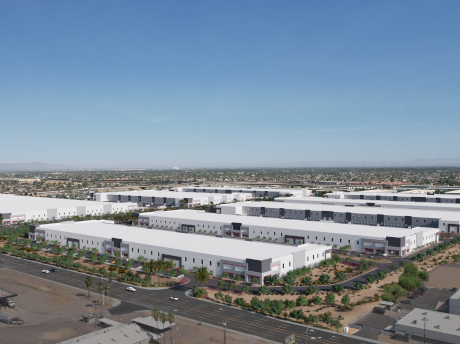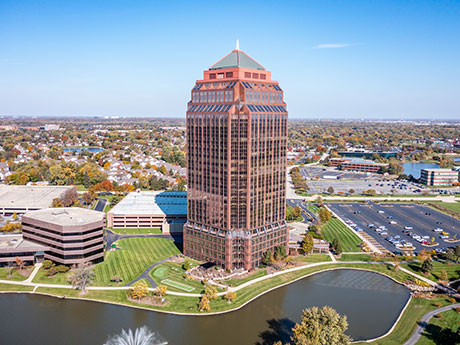By Randy Lacey, SIOR, senior vice president, CBRE | Oklahoma City; and Chris Zach, CPA, associate, CBRE | Oklahoma City Contrary to popular belief, the ongoing pandemic has been a boon to many aspects of the Oklahoma City economy. Industrial real estate growth has been more prominent than any other commercial sector. Those familiar with the city and surrounding area can vouch for the speed and intensity of housing demand and development, but industrial real estate has set itself apart over the last few years. OKC is Here to Stay Oklahoma City has a lot going for it. The market always has been well-positioned in terms of its central geographic location at the intersection of Interstates 35 and 40 and has seen tremendous growth and success in the last decade, with significant headway in the local industrial real estate market. The industry has proven its resiliency amid the pandemic and should continue to fare well into the future. But low costs of living and doing business have further bolstered the appeal of the community. In fact, Oklahoma City is only one of 14 cities across the country to add more than 100,000 people in the last 10 years, …
Market Reports
Raleigh-Durham is increasingly popping up at the top of shopping lists for multifamily investors, and buyer demand — coupled with strong rent growth — is resulting in record sale prices. As of this writing, 2021 is on pace to be one of the best years ever in terms of total transaction volume. As capital continues to flow into the market across the spectrum of investor groups from institutions to high net worth individuals, cap rates also have dropped into record territory. Just about every sale in the market is trading at a cap rate in the 3s, and even sub-3 percent in some cases. For example, Northmarq recently brokered the sale of the 489-unit Indigo Apartments in Morrisville on behalf of Blue Heron Asset Management. The asset sold for $121.9 million. The deal was one of the largest single-property multifamily sales in North Carolina in 2021, and the largest in Raleigh-Durham’s history upon closing. The property received multiple qualified offers before selling to Toronto-based Starlight Investments for $249,000 per unit, surpassing initial pricing guidance by nearly 20 percent. The phenomenon of lower return expectations and compressed cap rates is not unique to the Raleigh-Durham market. That trend is occurring throughout …
By Pat Harlan, Managing Director, JLL Labor, geography, population growth and a steady stream of cost-effective, “speed to market” solutions make Phoenix one of the most dynamic industrial markets in the country. Based on existing fundamentals, 2022 is on track to be another record year. As of third-quarter 2021, Phoenix had landed just under 16 million square feet of net leasing year-to-date. Absorption had improved by more than 28.5 percent in the same 12-month period, to total 8.5 million square feet. Nearly 94 percent of that activity was generated from ecommerce and food and beverage users. Vacancy had also dipped to pre-pandemic levels, falling by 100 basis points year-over-year to just 6.8 percent as of the end of the third quarter of 2021. Construction continues to ramp up, trying to meet a seemingly unending stream of demand. As of the end of the third quarter, there was 16.6 million square feet of metro Phoenix industrial space under development. The West Valley accounts for about 11.3 million square feet of this activity. The Southeast Valley represents an additional 3.4 million square feet. Two of the largest buildings underway in the market right now are the Cubes Glendale, totaling 1.2 million square feet, and Building …
The United States has been experiencing a housing crisis for years, one that is perpetuated by the COVID-19 pandemic. Whether it’s a lack of affordable housing properties for low-income families, a steady increase in housing prices over the years or exponentially high demand for new homes, the U.S. housing market within the past decade has been a wild ride. Indianapolis growth In the heart of Indiana, we’re seeing a hopeful trend. Indianapolis (Indy) was ranked as the fourth best housing market positioned for growth in 2022. A variety of factors could contribute to this distinction. For one, Indy is a thriving city and centrally located — not just within the state, but in the U.S. It’s home to two professional sports teams, and recently named one of the best cities for creating tech jobs by Forbes, with Fortune 500 corporations like Eli Lilly and Salesforce headquartered throughout the vibrant downtown. Marquee universities such as IUPUI, Butler and IU Medical School also bring more jobs into the fold. The 2020 Census found that metropolitan areas like Indianapolis are at the forefront of the state’s growth. Marion County remains the most densely populated county with more than 950,000 residents. Currently, the average …
By Taylor Williams In late October of last year, Raphael Bostic, president of the Federal Reserve Bank of Atlanta, gave a virtual speech in which he carried a glass jar with the word “transitory” labeled on it. Inside the jar were wadded-up dollar bills, deposited by Bostic’s staff members each time they used the word “transitory” to describe the surge in prices of consumer goods and services. The exercise was meant to dispel the notion that the current inflationary environment would be fleeting or short-lived. Based on the results of Northeast Real Estate Business’ annual reader forecast survey, commercial brokers and developers/owners in the region aren’t likely to be contributing to that fund any time soon. Inflation Could Linger When asked to identify the macroeconomic force that was most likely to impact the commercial real estate industry in 2022, roughly a third of broker respondents selected inflationary pressures over supply chain constraints, pandemic restrictions, the $1 trillion infrastructure bill and employment/gross domestic product (GDP) growth. Concerns over pandemic-related restrictions on businesses, which adversely impact demand for space, was a close second among broker respondents. Some brokers elaborated on these views in the free-response section of the survey. “Continued inflation will …
By Cecilia Hyun, Siegel Jennings Co. Since early 2020, the COVID-19 pandemic has upended lives and disrupted the normal course of businesses, including those in the commercial real estate market. As in many other sectors, however, this public health crisis has not affected all commercial properties equally. Real estate occupied by essential businesses such as grocery stores, sellers of household goods and warehouse clubs, for example, have weathered the pandemic well. A few have even increased their market share. By contrast, many office buildings, hospitality and non-essential retail properties have suffered severely. Taxing jurisdictions and assessors have responded to the crisis with varying degrees of success. The Ohio Legislature passed special legislation (spearheaded by Siegel Jennings Managing Partner Kieran Jennings) to allow a onetime, 2020 tax year valuation complaint for a valuation date of Oct. 1, 2020, since the usual tax lien date of Jan. 1 would not have shown the effects of COVID. Other assessors applied limited reduction factors to account for the sudden pandemic-induced decrease in property values. As values recover, it is important for taxpayers to monitor still unfolding consequences as they review their property tax assessments. Initially, hotels and experiential property uses suffered the steepest losses …
By Mark McAdams, Vice President, JLL While the Inland Empire is more well-known for its industrial real estate, the region’s office market has continued with its own success and stability pre- and post-COVID. As employees of office buildings seek refuge from high home prices in neighboring Los Angeles and Orange counties, occupiers equally appreciate the accommodating office rental rates while supporting their employee’s draw to the region. The current office market is in nearly the same place it was at the end of the first quarter of 2020 when COVID appeared on the scene. The overall market vacancy rate stands at 7.8 percent. Some of the submarkets have lower vacancies today than in the first quarter of 2020. Some smaller submarkets have seen even lower vacancy rates down to unprecedented levels at 3 percent to 5 percent. Only one submarket, San Bernardino, has a double-digit vacancy rate at 12.6 percent, and that is still considered healthy. Anything sub-10 percent is generally considered a landlord’s market. These are historically low vacancy rates that have rarely been seen since the area started developing the bulk of its office inventory in the mid-1980s. The pandemic put a hold on rental rate increases that had …
Orange County’s Multifamily Market Stays Strong as New Inventory May Curb the Supply-Demand Imbalance
by Jeff Shaw
By Peter Hauser, Principal, Avison Young The Orange County multifamily sector is extremely strong. Rents continue on a positive upward trend and occupancies remain very high, hovering around 97 percent. It is unquestionably a landlord’s market. Many years of supply constrained NIMBY-ism that created the lack of new construction is coming to an end, however. The California governor has mandated that cities approve quality residential developments with the goal of increasing density and combatting the significant housing shortage. There are currently 6,800 new multifamily units in the process of being delivered. While there are projects in the majority of cities, Irvine, Anaheim, Orange and Santa Ana are seeing the most development activity. Some very active Orange County developers include Trammel Crow Residential, Alliance, the Irvine Company, Western National Group, JPI, Wermers Companies, Avalon, Fairfield, Shopoff Realty and Garden Communities. Alliance Residential is nearly complete on its 1,221-unit Park & Paseo in Santa Ana, near the border of the master-planned Tustin Legacy community. Wermers Companies is also in the process of finishing the 603-unit Elan, located less than a mile from downtown Santa Ana near the intersection of the 55 and 5 freeways. The 653-unit Avalon Brea Place is starting to …
The I-40/I-85 Corridor is an emerging distribution area with a remarkably strong tenant mix between national manufacturers and distribution users, making it one of the most fundamentally sound corridors in the Sun Belt. The I-40/I-85 Corridor, squarely centered between the Triad (Greensboro, Winston-Salem and High Point) and the Triangle (Raleigh, Durham, Chapel Hill), is home to companies such as Walmart, Lidl, Ford, Kidde, Amazon, Chick-Fil-A, UPS, Lenovo, FedEx, Coca-Cola, among others. This corridor is seeing rapid expansion and is poised to be an epicenter of industrial activity in the region as the logistical significance of the area is attracting larger users and a growing amount of institutional capital. Recently, this submarket has seen significant demand from larger users leading speculative developers to plan large, Class A industrial parks. Historically, the market has been dominated by older manufacturing buildings. The newer development in the area is making these properties more obsolete due to their lower efficiencies, a phenomenon marking a larger shift in the composition of the emerging submarket. The industrial inventory’s makeup is continuing to evolve over time, marking the transition from smaller manufacturing properties to distribution and significantly larger manufacturing operations. Buildings currently under construction are average a footprint …
By Phil Breidenbach, Senior Executive Vice President, Colliers Companies are coming back to the office in Phoenix. Businesses are envisioning the return of their workforce as many look for new space or reconfigure their existing facilities. Building owners feel the momentum. We have reason to be optimistic — the future of the office and how we use the workplace is exciting! Getting there, however, will be turbulent. Your patience may be tested. Colliers’ fourth-quarter office report shows vacancies stabilizing market wide, positive absorption occurring in key submarkets and rents increasing marginally. Positive fourth-quarter absorption was led by leasing in new Class A+ buildings like 100 S. Mill. This Hines/Cousins project is 80 percent leased by institutional, “household name” tenants at record rents several months prior to completion. Vacancy rates may, however, continue to fluctuate as certain downsizing continues. Some institutional users are adopting work from home for much of their workforce, convinced this strategy will help with employee retention and cost reduction without impacting productivity — assumptions yet to be proven. This strategy has corporate America subleasing space, allowing leases to expire and vacating spaces, which is stagnating recovery. ‘Short Term’ — The Renewal Mantra for 2022 We speak with office occupiers regularly about back-to-work strategies. …










